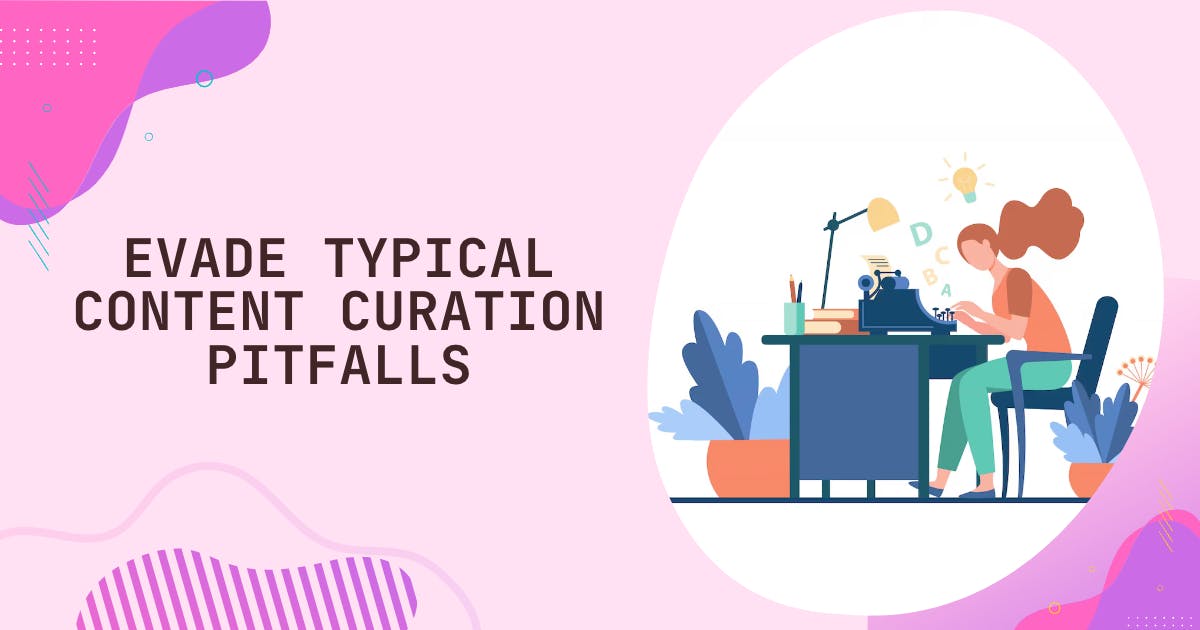Content curation is huge these days, and for good reasons. Google is crawling the web and adding new pages like crazy—we're talking hundreds of millions of new pages each month! Can you imagine having to plow through thousands of blog posts, zillions of news reports, hours of video footage, and who knows what just to dig up a few gold nuggets of useful info?
Because of this massive boom in both content and options, regular folks simply can't keep up without some help. That's where content curators come in. They help filter through the noise and uncover the most useful, relevant content created by credible and authoritative third-party sources on a topic by gathering, organizing, and distilling the best content into a digestible form for their audiences. We rely on and value curated content collections because they solve a need.
Therefore, readers subscribe to newsletters, follow certain authors, and join websites and online communities where others help point them to the best and most interesting content. We tend to trust curators with a track record of finding and highlighting great stuff.
Alright, the big question on your mind right now is probably whether content curation can have any role in your overall link-building strategy. Well, let us tell you, you're in for a shock! Curating content can be a total game-changer when it comes to building high-quality links.
In the next part, we're going to chat about a few ways curating content can score massive amounts of authority links and turn you into an industry superstar. If you're not sold yet, stay tuned with us; you will be soon!
We'll also share a definitive roadmap of a perfect content curation strategy for link-building and SEO with lots of tips and tricks in this brief piece, so don't skip anything until the end.
Why must you include content curation in your link-building strategy?

If you're stuck wondering why curating content is worth the hassle for link building, we have some killer reasons for you! Content curation is no passing trend—it's seriously legit for scoring high-value backlinks and needs to be a huge part of your link-building strategy.
1. Natural linking opportunities that drive referral traffic
For starters, curating content opens the door for some natural links. When you feature other influencers and link to their hottest content, they'll often shoot a link right back at your site. Win-win, baby! You're putting them in front of new peeps and stroking their ego by highlighting their best stuff. In return, they send traffic your way and boost your authority.
2. Builds credibility and authority
Curating content also shows everyone you're the real deal and builds trust. You're doing folks a solid favor by sorting through the junk and only sharing the best insights and info in your industry. Your audience starts relying on and believing in your curated content. And as their go-to expert, more people will want to link to you and your site.
3. Increases brand awareness
And if that's not enough, content curation expands your visibility, gets more eyeballs on your brand, and brings referral traffic pouring in. As you build your rep for featuring the top resources, more people follow you, share your stuff, and link to you as the authority. So content curation equals valuable backlinks and authority. It's a long-term play that pays out big!
Before you get started, though, you must figure out who your audiences are and the kinds of content and resources they care about most. Once you get your readers down cold, you can tailor your curated content to exactly what they need and want. And that will make your link-building push even sweeter!
So now we're going to dive into how to get real close to your target audience for content curation and link building. Get ready to wow them and bring on the backlink love!
Identify your audience

The first thing you have to do is know your audience better so that your content curation and link-building become far more compelling and relevant. Your audience is your tribe, so if you don't know them inside out, how will you curate content and score links they actually want?
1. Demographics
Start by figuring out some basics of your audience, like age, location, job titles, interests, etc. The more details, the better! Then dig into what kinds of content and topics they are looking for, what publications and influencers they follow religiously, what types of links and shares they go crazy for on social media, and so on.
2. Topics of interest
Learn your audience's pain points, questions, and goals, too—the stuff that keeps them up at night. Curate content that speaks to that, and they'll stick to you like glue! Your audience needs to know you get them and are providing value.
3. Publications they follow
Spend time observing your audience in their habitat. Engage with them on social media, LinkedIn groups, Q&A forums, and wherever they flock. Pay attention to the kinds of content, links, and resources they share most. You'll find endless inspiration and ideas for your content curation!
Why knowing your target audience is crucial for link building?
Getting insights into your target audience will make your content curation and link-building 1000x more effective. Your tribe will go wild for content that speaks to them, and the influencers and publications they follow will be way more apt to link back to that fantastic content.
In short, the better you know and can speak to the specific goals and interests of your readers, the more persuasive and valuable your link outreach within that niche community becomes. Precision attracts partners; It's a no-brainer!
Now that you've got a clear picture of your audience, it's time to find quality sources to curate from. We're talking blogs, news sites, influencer content, tools, stats—you name it. The more authority sources you have, the more on-point curated content you can provide your people.
Find and monitor quality sources

Now that you know your audience backward and forwards, it's time to start scoping out quality sources to curate content from. We're talking blogs, news sites, tools, influencers—whatever provides the information and resources your audience geeks out over. Remember, the more killer sources you have, the more share-worthy content and links you can offer.
1. Follow publications and influencers your audience already trusts
Start by listing the major influencers, publications, tools, and blogs your audience already follows. Those should be at the top of your curation list. You know that content will resonate since your people are already into it. Look for more sources in those same niches and categories. Chances are, if your audience digs them, they'll dig other similar resources too.
2. Keep an eye on trending news and discussions
Pay attention to trending topics and news in your industry so you can stay on the cutting edge. Follow thought leaders, journalists, and resources reporting on the latest tools, tech, strategies, etc. Consider the sources breaking news and insight first; your audience will eat it up and see you as plugged in.
3. Search for case studies, how-tos, and stats
Check review sites like G2 Crowd or Capterra for the newest, most popular tools and services. Curate sources discussing industry case studies, how-tos, and actionable advice. Stats and research from authoritative resources are always good to include too. Back your curation up with facts and data.
4. Use tools to discover popular and shared content
Make sure to utilize tools like Google Alerts, Buzzsumo, Feedly, or Followerwonk to find social shares and backlinks for content in your niche. See what's trending and being talked about, then trace that back to the source. Curate from sites consistently putting out information your audience cares about.
5. Include analysis and context
However, don't just share a link dump! Curate the best of the best and provide context—your analysis and insight on why those pieces matter. That's what your readers really want.
How quality sources fuel high-value link building
Relying on up-to-date, reputable sources when curating content is important for building trust, credibility, and authority, which then forms the basis for effective link-building. Here's why super high-quality sources are the launchpad for major link wins:
Credible sources establish your expertise: When you cite robust statistics, research, and perspectives from experts and influential voices within your niche, it signals you curate with discernment and authority. Sites are more willing to link to your posts as a result.
Accurate, current sources maintain freshness: Outdated or inaccurate sources undermine your status as an expert resource, reducing your appeal to sites looking to link to valuable, timely content. Vetting sources thoroughly ensures the freshness that attracts links. Outdated or incorrect sources kill your cred as a go-to resource, making sites less likely to link to your stuff.
Diverse sourcing adds depth: Curating from multiple authoritative perspectives and case studies within your niche demonstrates not just expertise but range and thoroughness sites desire in the resources they endorse. Diverse sourcing displays a more well-rounded grasp of your topic.
Transparent sourcing invites collaboration: Being openly cited and linked to your curated content can motivate sources to promote your work through their networks. Properly crediting sources lays the groundwork for potential link-building partnerships.
Evolving sources sustain relevance: Continually updating your sourcing to reflect the latest thinking, innovative research, and emerging voices keeps your curated content fresh and compelling, boosting the likelihood that sites will want to link to and promote your continually optimized resources.
The bottom line is if you want websites to take notice of your content curation and throw you some backlink love, there's no shortcut: you have to nail the sources.
In the next section, we'll look at how to evaluate, select, and gather the most shareable resources to feature for your followers. Choosing the highest quality and most engaging content is key.
Select and gather relevant content

Your content must be top-notch and resonate with your target visitors to provide value and build authority. Consider yourself a filter for the most relevant, compelling information that will genuinely attract your audience.
1. Prioritize what you know your audience will care about
Review your reader's interests, pain points, and goals. Look for content and resources that speak directly to those topics and questions. Your curation should give them practical solutions, insider tips, trending news, stats, or tools they can act on. If the content doesn't clearly help or engage your audience, keep looking until you find the right resources.
2. Evaluate content for quality and credibility
Look beyond just topic relevance—consider metrics like social shares, backlinks, author credibility, research cited, performance stats, etc., to determine content quality. Ensure to curate from authoritative sources and data, not opinion alone. Your curation builds trust when you share sound, well-researched information.
3. Pay attention to content freshness and originality
The latest, newsworthy content will appeal to your followers the most, so look for content published recently. However, some evergreen content and resources remain useful for a long time, so balancing fresh and unfading topics is vital. And make sure to offer a unique perspective—not just re-reporting what everyone already knows. Your audience wants new angles and something original.
4. Schedule time each day to find content
Don't leave finding content to chance or when you have spare time. Set aside some time daily to search your sources and evaluate content. A consistent routine will make the process efficient and ensure you always have a pipeline of assets to source from.
5. Save content to folders in your browser
Create folders in your browser to save content you want to potentially curate. Have separate folders for fresh trending news, popular how-tos, tools and resources, influencer content, etc. Staying organized will make the next step of sorting and selecting content much easier.
6. Use curation scheduling tools
Tools like RecurPost, Edgar, and Drip let you plan, organize, and schedule social shares, blog posts, and email newsletters in advance. Use them to schedule curated content ahead of time so you have an automated system in place and never run out of resources and updates to share with your audience.
Relevance rules: The secret sauce for link-worthy curation
If you want sites in your niche to take notice of your content curation efforts and sprinkle some backlinks your way, focus on one thing above all else: relevance.
The most shareable, linkable curations zoom in on topics, fill knowledge gaps and highlight perspectives that speak directly to your specialized readers. When you round up resources that solve problems, answer questions, and satisfy curiosities for your niche audience, you position yourself as an indispensable insider resource.
The more relevant, targeted, and indispensably niche-focused your content curation, the more persuasive and compelling your outreach efforts become—because you've proven you truly understand what resources and insights will provide the most value to that community.
But just sharing links alone won't cut it—your audience comes to you for guidance and recommendations they can count on. It's time to build your credibility as an insider expert!
Add your expert commentary and analysis

Curating content from the best industry sources is a great start, but it's not enough. Anyone can post links to useful content—what sets you apart is your expertise and insights on why those resources matter. Your audience turns to you for trusted guidance. So give them opinions, tips, and your interpretation they can't get elsewhere!
1. Discuss how resources solve critical audience problems or answer questions
Explain how the content you curate delivers real value. Will it save them time or money? Inspire new strategies? Offer details on exactly how the content gives your audience a leg up, and back up your opinions with evidence from the resource and your own experience.
2. Share how you have put advice or tools into action
Doing a case study? Clarify the way you implemented the tips or used the tool and the results you achieved. Real-world experience and examples add major credibility. Your audience wants content and advice that's been battle-tested.
3. Compare or contrast options when curating reviews or comparisons
Don't just feature the latest roundups of tools or software—share your reviews and opinions too. Compare items side by side and tell readers which you recommend and why based on features, usability, customer service, or ROI. Your analysis helps buyers make the smartest choice.
4. Include key stats or data and explain the implications
Incorporate crucial metrics, trends, or stats cited in research that shape how people in your industry should act or the decisions they should be making. Give readers a clear call to action based on industry analysis. Opinions backed by hard data and facts are the most compelling.
5. Integrate perspectives from multiple experts or influencers
When curating what different thought leaders or studies report, tie it all together and discuss the collective impact. Combining several resources around one important topic gives your audience a single, cohesive takeaway from multiple trusted sources, adding more depth and authority.
No barebones roundups here: How expert analysis wins you links
You want websites to throw some links your way for your content curation, so don't just string together a poor collection of meh resources. To attract links, you need to add serious value through your own expert commentary and analysis.
Websites aren't lining up to link to a dry list of articles and studies. They want curated content that shines a spotlight on what's IMPORTANT. That illuminates interesting CONNECTIONS. That EXTRApolates key takeaways and lessons learned. And they only trust analysis coming from someone widely seen as an AUTHORITY in that field.
So when you curate, extract the most compelling insights, surprising facts, skills gaps, and knowledge nuggets from sources. Highlight the most controversial or contested perspectives. Compare and contrast viewpoints. Raise unanswered questions. And provide your own recommendations based on your expertise in analyzing resources on that topic over time.
The more valuable, unique, and authoritative your expert commentary and analysis are on top of the resources you've gathered, the more irresistible and link-worthy your content curation becomes. So don't just list or summarize, but synthesize. Breathe life into information through your expertise.
Now, with your expert commentary added, there's one more step to take before pressing "publish" - giving proper attribution. After all, the content you're curating comes from others, and it's important to recognize them appropriately while also building your own authority as an industry expert. Next up, let's look at how to take that attribution to the next level.
Attribute content properly

The content you're curating comes from resources and influencers your audience already recognizes and respects, so giving proper credit builds trust. Attribution is vital—share where you found information, quotes, stats, tools, or advice and link back to the original source.
Best practices
There are a few recommended approaches while attributing you want to follow:
· Link back to the original source article or content, not just the homepage.
· Mention the author or publication by name in the text where you cite them.
· Use quotes when directly quoting a portion of content word-for-word. Share from where in the piece the section was taken.
· Summarize or paraphrase ideas or stats in your own words, or use snippets rather than full republishing and note according to Source X. Don't lift passages wholesale without quotation marks.
· Hyperlink text like "As reported in Resource Y" or "Tool Z recommends..." to provide context before sharing advice or information from another source.
· It's important to link to images or graphics instead of reposting them yourself if possible. If reusing something visual, ensure proper attribution and check copyright or terms of use to avoid any violation of the same.
Why proper attribution sparks backlinks
Properly crediting your sources shows you curate ethically and responsibly, boosting the chances sites link up. Here's why:
· First, attributing sources transparently signals you operate with integrity. Sites prefer to endorse and link to creators they trust to give credit where it's due.
· Second, attribution often motivates sources to promote your work through their networks. When you send roundups to authors, experts, and organizations you've cited and credited, they're more likely to share your curation with their followers, gaining you valuable exposure and links.
· Third, linking directly to influential sources from your roundups raises your own visibility to their audiences. It also strengthens your reputation as an insider expert and shows you know exactly where to find the information that matters most. Readers appreciate your curation for featuring resources they value, increasing their likelihood to link back and share your content.
When you have a strategy for proper attribution in place, you're ready to choose how you want to deliver your curated industry insights and recommendations to your audience—the options are plentiful! Next, let's explore the most popular content curation formats to determine what will work best based on your goals and available time.
Choose a content curation format

You have insightful industry knowledge and resources to share, so now determine how to share it! You need to consider your audience, goals, and available time to determine the best format, and when done well, it builds authority for both your own brand as well as the resources you curate.
1. Blog post:
This is ideal for an in-depth analysis of resources on a focused topic, allowing you to share quotes, examples, images, videos, stats, etc. However, one needs lots of time and the ability to write lengthy posts.
2. Roundup post:
It highlights and links several resources on a theme while briefing summaries and your recommendation/opinion for each. This format does require reasonable time to compile and briefly summarize the content.
3. Email newsletter:
You can also share your curated content or links in newsletters to email subscribers. It adds value and builds anticipation for your blog updates or new resources. Please note that you must commit to sending regular newsletters on a schedule.
4. Social media posts:
Another reliable format is sharing curated links, stats, tools, articles, or quotes on platforms like Twitter, LinkedIn, and Facebook. While this is a quick way to spread useful resources and your insight, you should invest enough time to engage with followers and keep social profiles active.
5. Video:
You may choose to review or highlight tools and resources on video if you're comfortable with the camera. Or you may choose to do a screencast of a tool in action. Remember that it requires a proper video hosting setup, and you must be savvy with technical know-how to present well on camera and describe content engagingly.
6. Podcast:
This is another trending format where you can discuss trending topics or resources, interview influencers you curate from, and take questions from listeners. Although a long form of content curation, but an impactful one that needs extended time to record, edit and publish regular episodes and promote the podcast.
Mix and match formats based on available time and resources. Start with one platform, then expand as your audience and curation skills grow. Consistency is key—whatever you can commit to on a regular schedule.
Pick the right format and watch those links roll in
If you want to attract links through your content curation, the format you choose makes a BIG difference. Different styles resonate better with different websites and audiences, so experiment with formats to maximize your link-earning potential.
· Lists are easy shares: Websites love linking to simple roundups and lists because they're easy to consume and promote.
· Guides and how-tos drive action: When you curate tutorials, checklists and step-by-step guides, you create content that will do more than just sit—it'll activate readers.
· Visuals capture attention: Infographics, image-heavy content, and videos cut through social feed clutter and catch the eye. The more eyeballs, the more chance of earning backlinks.
· Evergreen content endures: Long reads, reports, and analyses featuring novel perspectives on timeless topics attract links that build over months and years.
· Bridge format gaps: Assess which formats niche sites don't typically create themselves but their readers want. Curate in those styles to close gaps, incentivizing sites to link as a valuable resource.
· Target preferred promotion types: Find out how niche sites typically promote and share curated content that gains the most traction for them.
· Amplify existing strengths: If your favorite format already succeeds at gaining links, continue experimenting within that genre to improve and evolve your approach.
So research the types of content different sites in your niche typically link to and promote. Then experiment with formats to create a curation they simply cannot resist: a straightforward, actionable, visual, insightful resource perfectly tailored to their specific readers. And see how those links start pouring in!
With your ideal format(s) chosen based on goals and audience, you now need to focus on crafting your content curation strategy and publishing schedule to create a sustainable and impactful system for sharing valuable resources. A smart strategy and posting cadence can make you an industry leader.
Build your content curation strategy

A carefully crafted content curation strategy is the foundation for building authority and sharing resources your audience will genuinely benefit from. Without a plan, curation becomes an inefficient process that yields lackluster results where you'll end up spending more time determining what and how to share than actually executing.
A sound approach, on the other hand, streamlines your efforts into an organized system for discovering and distributing the most useful and relevant resources and helps establish your credibility as an insider expert and information hub that your audience comes to rely on. Let's look at how to develop an effective yet sustainable content curation strategy.
1. Focus on a content theme or topic:
Start by curating resources around a specific theme your audience cares about, like email marketing, project management, customer service, etc., which makes your recommendations highly targeted and valuable.
2. Set a regular posting schedule:
Decide how often you'll publish curated content each week or month. Start conservatively, then increase frequency as you improve your workflow and build an audience. A consistent schedule strengthens your authority.
3. Find an efficient workflow
Develop a simple process to discover, evaluate, select, and share the best resources for your needs. Reuse at least part of your workflow for each curation to avoid reinventing the wheel each time. Look for ways to optimize and organize your steps.
4. Prepare in advance when possible
If doing blog posts or videos, you may curate some resources for a future piece now. Save items you don't use immediately; they may still be worthwhile. Having resources queued up and ready to go saves time down the road. But don't curate too far in advance, or the content and stats may become outdated.
5. Mix up topics and types of content
Switching between different themes or resource types keeps your audience engaged and exposed to a wider range of helpful content. For example, curate industry news one week, tools and software the next, case studies after that, and tips from influencers to follow. A steady diet of the same narrow focus each week may seem repetitive, but variety creates more value.
6. Start small and build momentum
Don't feel overwhelmed by thinking you must post curated content on every possible platform right away. Focus on mastering one format and engaging one audience at a time. As you establish consistency and authority, consider expanding to additional formats, topics, and channels.
7. Promote your curated content for maximum visibility
Merely publishing your curated posts, videos, and resources isn't enough. You also need to actively promote what you share on social media platforms where your audience spends time. Engage by replying to comments and mentions, and run social contests and giveaways to increase exposure. You can further pitch your content to influencers for backlinks or mentions. And last but not least, email your list with links to each new curation.
Get strategic in your content curation to acquire those links
Developing a clearly defined content curation strategy and continuously optimizing it has huge benefits for any link-building efforts through your content.
A cohesive strategy ensures all parts of your curation efforts work together to achieve two key outcomes: providing maximum value for readers while demonstrating your authority clearly and compellingly to potential linking partners. You curate with a purpose that boosts linkability.
Now your content curation strategy is set, but choosing a platform to help organize the process can make sharing your resources even more efficient. Several tools allow you to discover, curate, publish, and engage your audience—all in one place. So let's look at some of the most popular options for empowering your content curation efforts online.
Choose a content curation tool or platform

Publishing curated content regularly requires efficiency. From researching to promoting your resources, the right tool enhances the process. You can consider options like:
1. Feedly: Follow thousands of sources, discover trending content, save items for curation, and easily share them on your social profiles and blogs. It offers a free option with paid Pro version.
2. Scoop.it: Curate and publish resources on your online topic hub. Their Content Director tool provides suggestions based on your interests with social sharing, and email list features are built-in. Both free and paid Business plans are available here.
3. Curata: Research trending topics and content from thousands of authoritative sources and share directly to social media, email newsletters, and your blog. Curata features plans for teams and brands in addition to individuals.
4. Flipboard: Follow interests and influencers to curate articles, videos, and audio into your own digital magazine. Social sharing features included. Flipboard is a free tool.
5. Elink.io: Share links with short descriptions and images on your Elink profile or embed them on your site/blog while following influencers and topics to discover new content to curate. The basic account is free.
6. Pocket: Save content from any source to read and curate later, tag items by topic for easy sorting, and share to your social profiles, email lists, and blogs right from the app. Pocket is one of the top apps that offer advanced features for content curation without any subscription fee; however, a few advanced options, like no ad, access to deeper research, and more, are available in their premium package.
7. Twitter Lists: Organize influencers and resources into Twitter lists by topic or category to curate the best tweets, stats, tools, and conversations from list members. It's a free feature for Twitter users.
8. Google Alerts: Get alerts on new web content for your topics of interest. Great for ongoing resource discovery but lacks built-in social sharing and publishing options. However, you can utilize other tools to share items you curate from your alerts. This tool is free to use for all with a Google account.
9. Medium: Publish your curated content as articles on Medium and build an audience that likes and shares your work, attracting more traffic and backlinks. You can access and curate unlimited content from the platform for a mere $5/month or a $50 annual fee.
10. LinkedIn: Curate content and share in LinkedIn posts to engage your contacts and professional networks. Curated LinkedIn posts get high engagement and backlinks. This social channel costs nothing unless you want premium features.
Use a combination of free tools and affordable software platforms that make the curation process efficient based on your needs. One can take advantage of trial offers to test different options before committing. The right blend of tools will ultimately strengthen and scale your content curation efforts, building valuable resource libraries and discussions your audience will want to refer to.
Pick the perfect curation toolkit to supercharge your link-building drive
The platforms and tools content curators use to produce and promote their work have a big impact on how easy it is to attract links.
For example, curating and sharing content efficiently requires a smooth workflow enabled by the right set of tools—from research and writing aids to social publishing plug-ins. The faster and easier you make curation, the more links you can earn over time.
Also, creating curated content in formats that platforms heavily feature and promote gives you a built-in advantage. When algorithms highlight your work, exposure increases, bringing in more traffic and link requests.
And in addition, integrating tools that enable personalized outreach at scale saves time and increases success rates. The more sites you can effectively pitch your curation to, the more links will say yes.
Create eye-catching headlines

Headlines are the first thing readers see, so crafting catchy titles that grab attention and instantly show value is crucial for content curation success. Here are some headline strategies that will make your readers take notice:
1. Numbers or numbered lists
· "7 must-read business trends for April"
Folks love a good list! Numbered headlines signal insights your readers won't want to miss. The number 7 implies multiple worthwhile takeaways and instantly triggers curiosity.
· "20 tools every content curator should know in 2023."
The big round number "20" carries impact and shows readers there are a ton of useful resources waiting in your curated post. They'll click through just to discover those tools that can help them do their jobs better.
2. "Best of" or "Top"
· "The top 10 posts on productivity hacks"
Using "top" indicates you've done the hard work of researching and vetting the highest quality content on the topic for your readers. They know they'll get the real cream of the crop rather than wasting time finding it themselves.
· "The best-curated articles on improving customer experience"
The phrase "best-curated articles" promises your readers an exclusive selection of must-read resources personally handpicked by an industry expert. It immediately establishes credibility and value.
3. Catchy questions
· "Will AI Soon Replace Content Curation?"
A provocative question headline gets readers asking, "What? No way!" and makes them curious. They'll dive in to find out your take on the future of their profession.
· "How Will the 'Metaverse' Impact Content Marketing?"
A timely, relevant question showcases your keen awareness of trends and ability to analyze emerging topics that impact your readers' work. They'll want to know your thoughtful take on an uncertain future.
Make headlines that grab links
You want websites and publications in your niche passing around your content curation like a hot potato, so give them a compelling hook they simply cannot resist sharing. So aim to stop readers in their tracks with a title that quickly conveys what sets your curation apart.
· Curiosity-sparking headlines pique interest: The more intrigued and excited websites are about your content, the more inclined they'll feel to spread the word about it.
· Action-oriented headlines or call-to-action motivate sharing: When your title promises concrete takeaways, real-world applications, and valuable next steps, it increases the chances sites will endorse your work as a resource for their readers to actually use.
· Provocative headlines trigger responses: Controversial or thought-provoking titles pull readers in and ignite conversations, increasing opportunities for your curation to be discovered, discussed, and ultimately promoted or linked to.
You need to be creative and resist bland, generic labels. Instead, craft headlines that make big promises about what's inside your curation.
Include visual content

Visuals can really spice up your content curation and make the resources you share stick with your audience. So don't be afraid to incorporate relevant images, infographics, graphs, and charts whenever possible. Here are a few tips:
1. Relevant images to break up text
Images can do so much more than just break up blocks of text; they actually make your content more engaging and memorable. So whenever you come across an image that neatly illustrates an article you're curating, by all means, include it! Photos of tools you recommend, company logos, product shots, and screenshots from articles you summarize can be powerful visual aids. For even more impactful visuals, consider utilizing an AI image generator to create custom graphics tailored to your content, enhancing its appeal and effectiveness.
The general audience has short attention spans. While you want to provide value through the resources you share, using photos judiciously can help break up long passages of text and keep readers engaged. Try experimenting—an image here or there can really improve the impact of the content you curate.
2. Infographics with curated statistics
If the resources you're sharing contain useful statistics and metrics, consider creating or finding an infographic to display that data visually for your audience. Infographics summarize complex information in an easy-to-digest visual format that boosts understanding and retention. So when curating reports, trending pieces, or case studies full of data, presenting the most valuable stats through an infographic is sure to make an impression.
Your readers rely on you to filter through content and share only the most relevant nuggets of information. An infographic is a great way to summarize the highlights visually. The right graphic can rise above the noise and channel the value of curated statistics into an instantly shareable format that amps up stickiness and credibility.
3. Graphs or charts related to topics
On the same note, whenever the content you curate already includes useful graphs, charts, diagrams, models, or processes, show them to your audience! Visual depictions of data, trends, relationships, sequences, and comparisons make complex ideas instantly graspable.
Wherever possible, let the images and visuals that clarify and strengthen the resources you share do the talking. Sharing graphs, charts, and visual displays created by credible sources within the content you curate allows your audience to directly benefit from those visual explanations, models, and overviews, saving them time and helping them to comprehend the concept effortlessly.
Why visuals score you backlinks
Visuals are your secret weapon, and they can make all the difference when it comes to scoring some valuable links.
· People notice visuals in an instant: Sites are scanning feeds at lightning speed, so content with visuals stands a much higher chance of actually catching their eye.
· Boosts processing speeds: Readers absorb and remember visual info a few times faster than text alone. So visual curation gets absorbed and shared more quickly.
· Visual storytelling stimulates emotion: Graphics, images, and charts imbue your curation that, pulls readers in, and compels them to pass your work on. Emotion fuels engagement and, ultimately, exposure.
· Visual variety fuels curiosity: Mixing up the visual mediums you use, from infographics to photos to graphs, introduces novel elements that maintain interest and invite sharing.
So as you build your content curation strategy, think about how visuals like relevant images, infographics you create, and pre-existing graphs from curated resources can increase the value you provide your readers. Visual storytelling has immense power to engage audiences and cement ideas—so make good use of it!

Sharing your curated content on social media can help boost visibility, build links, and grow your audience if you do it right. Here are some tips to get the most value from promoting your curations socially:
1. Spread over your networks for maximum visibility
The first step is to share your freshly curated resources across your own social profiles. Post them on Twitter, Facebook, LinkedIn, and any other relevant networks you're active on. Post the same update, slightly tweaked for each platform to suit the audience. But don't just dump the links—include an attention-grabbing summary highlighting the value readers will get from each resource.
Don't be shy—promote your hard work! Posting your curated content across your networks increases the chance of someone discovering and sharing, and linking to it. With the right summary, you can attract people's interest and entice them to click through for more. So make sure you spread the word, but do it meaningfully.
2. Engage with people who view and share the content
Keep an eye on your promoted posts. When people like, comment or share your curated content, engage with them! Reply to their comments, thank people for sharing and start conversations sparked by what you uncovered. This humanizes your curation and shows your audience you value their interest and feedback.
Remember, you're providing a service by saving people's time finding quality resources. So show your appreciation when people find value in what you share. Your engagement and responses can attract more shares, clicks and backlinks to your curated content over time. The more conversations you start, the more you expand your viewership.
3. Participate in relevant Twitter chats and LinkedIn groups
Looking for opportunities to share your curated content at opportune times is critical. That could mean participating in relevant Twitter chats in your industry where many potential readers are already gathered. Search by hashtags for chats in your niche and join in with some valuable insights from your recent curations. On LinkedIn, look for groups focused on your target audience and share your curated resources at relevant times in the conversation.
4. Share to industry-specific Facebook groups
If Facebook groups exist catering specifically to your target audience or niche, join those communities and share your fresh curations in posts. Be an active member who contributes value through both content curation and engagement with others to gain trust.
The key is to look for receptive online communities where your fresh perspectives and curated resources can meaningfully contribute at just the right time to be appreciated. So find ways to plug into relevant groups, as targeted social sharing like this often yields the highest value backlinks and visibility for your content.
5. Promote in relevant subreddits and Quora spaces
If you find corners of Reddit and Quora focused on your industry, share your curated resources as posts where they can productively contribute to ongoing conversations. Reddit and Quora users appreciate quality sources that add value, so curated content can perform well if shared at the right time.
6. Ping influencers in your niche
When you discover useful resources, think about journalists, podcasters, bloggers and other influential figures in your industry who may find value and share your curation further. Research the types of contributed pieces they publish, then craft a compelling pitch email outlining the key insights their readers would gain from your proposed post. Explain how curating and summarizing top resources has given you a unique perspective worth sharing.
Reach out and provide them with the most relevant pieces to their work from what you uncovered, acknowledging them as a potential source. Such outreach can result in links, mentions, and a wider audience for your content curation if done professionally.
7. Pitch roundup posts to online industry publications
Curating a roundup of the 5-10 most valuable resources you discover on a trending topic could make for a great post in industry publications relevant to your niche. Do some research to identify likely candidates, then reach out and personally pitch your proposed roundup post to editors. Explain how the curated resources provide crucial insights and how publishing them would benefit the publication's readers. A well-written, on-point pitch can result in opportunities to share your curation through industry channels.
8. Build relationships with editors, journalists, and major media brands
For maximum success pitching your curated content, build professional relationships with key editors and journalists in your industry over time. Reach out personally to comment on or share their work, cite them as sources in your own content, and send important information you think would benefit them. Consistently adding value this way cultivates trust so that when you do eventually pitch your curated resources, your suggestions will be received more favorably. Personalized outreach works much better than cold pitches.
Spread the word on social platforms to earn links
Actively sharing and promoting your curated content across social media platforms can generate backlinks over time. Here are the main reasons why:
· Social promotion amplifies the reach of your work, increasing the chances that niche sites notice and engage with your content.
· Generating engagement and interactions around your curation on social signals the value it provides, motivating sites to verify and reflect that value through links to the original source. Social proof boosts credibility.
· Building an audience on social media platforms where niche sites also maintain a presence gives you a ready pool of potential linking partners to pitch your curation to regularly.
Reach out for backlinks

Now, here's the crucial part: reaching out for those valuable backlinks you've been working so hard for! Your well-curated content and expert analysis has positioned you as an authority; now it's time to let others know about it. But you don't want to come across as spammy or pushy—you've got to be strategic and persuasive. Here are some suggestions:
Focus on quality, not quantity. A few high-quality backlinks from sites and influencers your audience trusts will be way more beneficial than tons of low-quality links. So target the publications and influencers that really matter in your niche.
Explain you both provide resources the other's readers would value and propose linking to your new curated post from their sites. Or offer to write a guest post highlighting useful tools, resources, and insights for their readers with links back to your site in exchange for them publishing your post. Such cooperative arrangements create a win/win where you're able to build lasting relationships and earn continual extra traffic and links.
However, do your research before you reach out. Read their work, follow them on social media, and mention or share their content to get on their radar. When you make that first contact, show you're already familiar with them and what value they provide. Flattery will get you everywhere!
When you're ready to pitch your curated content, be brief but intriguing. Something like "Hey Sally, I came across some really insightful resources on X topic that I think your readers would appreciate. Let me know if you'd be interested in seeing a quick summary I've put together." This gets their attention and shows you're courteous and respectful of their time.
If they're interested, follow up with a short, well-structured email highlighting the most relevant insights your curation uncovered, how it provides solutions or presents an interesting perspective, and most importantly, how publishing it would benefit their readers. Tell them straight up a link back to your site from theirs would be much appreciated!
Don't be too salesy - remain respectful, even if they pass on your pitch. But do follow up occasionally as your content evolves and you have even more value to offer them. Persistence pays off when done politely and professionally.
Additionally, the authors and creators of resources you curate from can be another prime target for outreach. Email them and express your thanks and admiration for their insightful content while linking to the curated post where you featured and analyzed their work. Let them know a link from their site pointing to your coverage would be greatly appreciated and mutually benefit your audiences. Many authors will oblige such a request when you've prominently showcased their content and expertise.
And finally, when you do score that sweet backlink, make sure to thank the influencer or publisher sincerely. A relationship has just begun, so continue engaging with them by commenting on new posts and occasionally sharing relevant, value-added content. Nurture that connection to unlock more opportunities in the future.
Monitor and learn from successful content curators

So you've built up your content curation skills, you're creating and promoting great roundups, and the backlinks are starting to roll in. Nice work! But now's not the time to rest on your laurels. If you want to achieve link-building mastery through effective content curation, you must keep improving your craft.
1. Note formats, designs, and headlines that generate shares and links
The best way to level up your curation game is simple: check out what the pros are doing and follow their lead! Pick a few content curators you admire, the ones creating resources that consistently provide huge value, and study what they're up to. Sign up for their email newsletters, follow them on social media, and read everything they publish. Pay attention to what types of content they're curating and how often. Notice the headlines, images, tools, and formats they use to build their iconic resource libraries.
It also helps to analyze what's making certain curated posts from influencers go viral. Was it the topic? The headline? Images or graphics used? Their existing authority and community? A combination of those elements? Reverse engineer their success to apply those lessons to your content.
2. Replicate and adapt approaches that drive high traffic and engagement
Once you get familiar with their style, try implementing similar techniques and tweaks into your own content curation process. Test out different content types, schedules, headlines, images, and tools to find the mix that works best for your unique audience and voice. Your goal is to determine what moves the needle for your readers the same way your role models do for their fans.
Over time, as you monitor your curation metrics, you'll get better at intuitively creating resources your readers can't get enough of. You'll build the kind of expert library and loyal following that makes a real impact. True content curation expertise comes from practice, optimization, and learning from the very best in your field.
3. Make use of online courses and expert tips to accelerate your content curation endeavor
Speaking of learning from the best, another way to take your content curation to the next level is through online courses and resources on the topic. There are some fantastic tutorials, video series, ebooks, and coaching programs explicitly designed to help content curators up their game on reputable platforms like Udemy.
Investing in a comprehensive content curation course is one of the smartest moves you can make. The insights and strategies provided by industry experts who've been there can quickly advance your skills and save you months or even years of struggling to figure things out on your own through trial and error. Their guidance can help you avoid newbie mistakes and adopt proven processes and best practices right from the start.
Free or low-cost content curation resources like blog posts, podcast episodes, video tutorials, and ebooks are also worth exploring. While not as robust as a full course, these materials are an easy way to pick up useful tips and hacks to incorporate into your existing efforts. Follow experts, join some online communities, and make a habit of reading whatever new resources on curation they publish or recommend.
Measure the impact of your content curation

How do you know which parts of your content curation efforts are actually shifting the dial? By digging into the metrics, of course!
Metrics provide insights that let you see what's performing well, determine what's falling flat, and make changes to optimize your impact. As a content curator, some of the key metrics you'll want to monitor are:
· Traffic: See how many people are visiting your site and content from search, social, and referring sites. Track which curated posts get the most attention.
· Social shares: The more people share your content, the greater your visibility and reach. Analyze which platforms and content types get shared the most.
· Backlinks: High-quality backlinks from influential sites give you authority and rankings boosts. Check which content and outreach strategies are earning you the best links.
· Subscriber growth: If readers value your curation, they'll subscribe to your platform, channel, or newsletter to get regular updates. New subscribers or email signups are a sign you're providing resources people want and need.
· Click-through rate: A high CTR means you've optimized elements like headlines, images, and previews well. See which of your curations get the most clicks.
· Bounce rate and time on page: Low bounce rates and longer durations indicate you're capturing attention and keeping visitors engaged. Improve if needed.
· Comments and mentions: People leaving feedback or talking about your work helps build community and credibility. Engage with those commenting and sharing to stay on their radar.
Analyzing metrics like these on a consistent basis provides the insights you need to tweak and improve your content curation over the long run. You'll get better at creating roundups and resources your audience finds irresistible, which is the mark of a pro content curator.
Repurpose and recycle your content curation

One of the most valuable skills any content curator can develop is learning how to repurpose their best content into a variety of formats. Why go to the effort of curating resources and analyzing topics if you only get to benefit from the value once? By reusing and reimagining your content, you extend its reach and impact.
Some popular ways to repurpose curated content include:
1. Turn top posts into multimedia assets
Convert a top-performing blog post into an ebook, slide presentation, video, or podcast episode. You've already created the content - now transform it into other media for broader accessibility.
2. Compile resources into evergreen libraries
Organize a series of newsletters, posts, or resources on a common topic or theme into a bundle or ebook. House your evergreen content in one place for readers.
3. Syndicate content as guest posts
Publish your blog posts as guest articles on other sites in your network. Promote your curation skills and resources to new audiences by publishing on authoritative sites in your industry.
4. Develop short courses from key insights
Build short courses or video training series based on the key strategies and takeaways from your content. Extract actionable insights to help others implement their own efforts.
5. Curation within curation: Roundup your roundups
Create roundup posts highlighting selections from your own library of curated content and resources, and repackage your previous work in new ways.
In short, you want to find fresh angles, extracts, and distributions, enabling you to squeeze more mileage from your content curation. Repurposing what you've already built prevents burnout and amplifies your results and impact over time through new delivery methods.
Recycle and rake in those links
Transforming your best content curation into multiple formats can help build backlinks, especially from sites that value continually fresh resources.
For instance, repurposing your previously curated content into new visual formats like infographics offers niche sites unique assets to promote, increasing your chances of exposure and linkage.
Moreover, often recycling curated roundups into different lists targeted at niche subsets and variations on the same topic expand your opportunities to find linking partners perfectly matched to each new iteration.
Keep your content curation strategy fresh

Now the real challenge begins: how do you keep your content curation efforts sustainable and avoid burnout? The answer is simple: stay agile and keep your strategy fresh.
1. Change content types and formats
Rather than relying only on standard blog posts, work in roundups, podcasts, videos, presentations, and other resources too. Variety keeps you creative and engaged.
2. Explore new topics and themes
Cover the same subject from multiple angles or branch into related areas your audience would value. Pushing into new territory fuels motivation and relevance.
3. Rotate between evergreen and trending content
Curate information and resources on both timeless subjects as well as emerging, popular topics making news in your industry.
4. Follow your passions and interests
The more personally invested and excited you are about the content, the higher your curation and analysis quality will be.
5. Improve your process
Stay on top of tools, technologies, and strategies in your space. Constantly improve your process with innovative new solutions and approaches.
6. Collaborate with other curators
Work together with influencers and peers on co-curated or promoted content. New voices and input lead to unique, valuable resources with a wider reach.
7. Get feedback from readers
Ask your readers directly what types of content and specific sources they find most useful and valuable. Crowdsource topic and content ideas to determine what interests and serves your audience best.
8. Track trends in content curation
Stay on top of analyses on the latest content curation tools, formats, topics, and strategies trending in your industry. Identify patterns and apply lessons from industry reports and resources to improve your own efforts before everyone else.
The reality of content curation is that it requires an ongoing time commitment to build skills, produce resources, engage with your audience, and promote your work. But by keeping your strategy nimble, following your passion, and nurturing collaborations, you'll establish a sustainable practice for the long haul. Keep your enthusiasm fresh, and you'll keep your readers coming back for more!
Provide value with your content curation

The key to building an audience with your content curation and establishing authority as an expert in your niche is offering ridiculous amounts of value. When you suggest resources and insights that actively help your readers solve problems or achieve their goals, you'll gain their attention, trust, and loyalty over the long run.
1. Curate with intent
Don't just round up any or all content on a topic. Be highly selective and only choose resources that will benefit your readers in a meaningful way. Analyze and evaluate content before including it to determine relevance and impact.
2. Address pressing needs and questions
Pay attention to the biggest challenges, pain points, and unanswered questions facing your audience. Curate content that tackles those needs and provides solutions and clarity in a helpful, actionable manner.
3. Share strategies, tips, and how-to's
Your readers will appreciate resources, tutorials, and examples that show them how to get ahead and work more efficiently and effectively. Curate detailed, practical guidance they can apply immediately to achieve results.
4. Focus on quality and credibility
Don't waste your readers' time on fluffy or superficial information. Select content from reputable experts, studies, statistics, and reports that cite credible sources and back up important insights and takeaways with facts.
5. Provide actionable takeaways and recommendations
Don't just summarize or rehash content. Analyze resources to extract key insights, conclusions, and calls to action your audience can benefit from. Provide your own expert perspective and recommendations based on your curation.
6. Give readers the next steps
Help your readers progress further by pointing them to additional useful resources, tools, strategies, and materials they can explore to build on the content you're curating. Show them where to go next to continue improving and achieving their goals.
When done well, content curation provides a high level of value that builds trust, authority, and community between you and your dedicated readers over time through relevance and solving their most pressing needs. Keep adding value, and your content curation can become an invaluable resource to help others learn, grow and get ahead.
Evade typical content curation pitfalls

As a content curator, it's easy to slip into some bad habits that undermine your efforts and results. Stay aware of these potential mistakes and course correct as needed to avoid wasting time and missing opportunities. With diligence and consistency, you can sidestep these common mistakes.
1. Curating too broadly or under-curating
Don't try to curate resources for too wide an audience or on too many unrelated topics that bury key gems. Narrow your focus to specialized, targeted areas of value for the best results to avoid irrelevance. Similarly, curating too little without adding enough value for readers wastes opportunities. Find the right balance of depth and precision to serve your audience optimally.
2. Not providing your own insights
Simply rounding up resources without any analysis or recommendations from your own expertise is a missed chance to demonstrate authority and build trust. Don't skip on adding your informed opinions and advice.
3. Overlooking key metrics and optimization
If you're not regularly checking key metrics to see what's working and what's not and optimizing accordingly, you're curating without a feedback loop. So, measure and improve to maximize your impact.
4. Neglecting promotion
Content curation is only worthwhile if people actually find and benefit from the resources. Don't spend so much time curating content that you forget to promote your work for visibility and traffic, as outreach is essential.
5. Lacking follow through
Many start projects with enthusiasm but fail to update, maintain, and build on resources over the long run. You must keep your content and outreach consistent and establish yourself as a reliable, dedicated curator.
6. Not developing a master library
Have a place to host all your top-performing, evergreen content curation for readers, like a resource page.
7. Rehashing other's work
Do more than just summarize resources in your own words. Analyze content thoroughly and extract key actionable insights, conclusions, and recommendations from multiple sources. Remember that repeating another's work without adding your own perspective lacks value.
8. Staying too narrow
Cover a topic in depth while still branching into related and valuable areas for your readers. Becoming too laser-focused prevents serving a wider set of needs and limits your growth as an expert resource. Find new angles and insights.
9. Outdated and Inaccurate Content
Relying on resources and research that are no longer timely or have since been revised can damage your credibility as a curator. Regularly check sources for updates and recency, and remove any stale content to maintain authority and keep things fresh.
10. Overreliance on a single source
Exclusively citing one blog, article, or author without pulling in multiple perspectives creates a restricted curation lacking depth and different viewpoints. Avoid confirming bias through confirmation curation, and include diverse sources.
11. Over-curating or under-curating
Either sharing too much irrelevant content that buries key gems or curating too little without adding enough value for readers wastes opportunities. Find the right balance of depth and precision to serve your audience optimally.
With vigilance, deliberate practice, and consistent optimization, you can sidestep the common traps that plague content curators. Learning what not to do is half the battle to long-term success.
Building relationships with other content creators in your niche

As a content curator, you don't operate in a vacuum—there are always other experts, influencers, and media outlets sharing resources and information with your audience. Rather than viewing them as competitors for attention, top curators see other content creators as potential allies and collaborators who can help boost the impact and reach of their work. Building relationships with creators in your niche benefits everyone involved.
1. Look for synergy
Seek out other influencers, blogs, podcasts, and news sites targeting readers interested in the same topics as you. Connecting and collaborating can double your exposure and value by pooling resources and audiences.
2. Give first
Reach out to congratulate creators on a piece of content you appreciated or found interesting. Share insightful feedback and then link to a valuable resource of your own as an example of your curation work. Think "give first to receive later."
3. Offer your expertise
Let other curators know your specialized niche and skillset, providing your contact info. Express willingness to answer questions, review drafts, or recommend resources for them in your area of knowledge. The favor will likely be returned.
4. Seek co-curated content
Propose collaborating on a roundup or listicle where each of you contributes angles, sources, and insights related to a common topic. Co-curated resources double the analysis and value for your combined audiences.
5. Request guest posts
Ask media outlets and blogs if you can share a top-performing roundup as a guest post, with links back to related resources on your site. A well-written post positions you as an expert while earning valuable links and exposure.
Content curation is part craft and part community. Building relationships with like-minded creators with overlapping goals and audiences lays the foundation for wide-reaching co-curated resources, cross-promotional opportunities, and mutually beneficial link-building that advance the interests of your niche as a whole.
Case studies: Let's look at some real examples of how curated content contributed to accelerated backlinks growth

Inbound Writers: Started by aggregating best writing advice and ranking writing sites for SEO value. As authority grew, so did backlinks from publishers using high-ranking writing resources.
Envato Tuts+: Launched as a tutorial resource, curating top education content for specific design/development topics, and offering free tools to audiences of niche sites. Link building followed as the platform recommended curated resources to solve problems.
Curata: Built a knowledge graph by curating the most valuable resources on over 950 business topics. Used AI to surface the best content. Increased expertise and narrowed niche focus over time. Links grew as they became seen as a go-to resource for specific verticals.
Tom's Hardware: Gained backlinks after launching their "build guides," curating the best hardware for specific PC roles. As popularity grew, so did requests from tech publishers to review upcoming products with curated lists guiding purchases.
Moz: Built authority by curating the best SEO advice from experts. Became a referral source for sites needing reputable SEO info. As they improved curation over time, so did links from sites directing readers to up-to-date Moz roundups.
These case studies show common elements for successful curation-based link building: start broad but niche down over time, fill knowledge gaps, improve curation constantly, and create evergreen assets. But the core remains: provide maximum value for niche communities and let links follow naturally.
Conclusion and key takeaways

Link building through effective content curation requires consistently producing valuable, shareable resources while strategically reaching out to relevant sites for backlinks. Here are the essential tactics:
1. Curate with authority
Focus on topics you're an expert in. Your authoritative analysis, reporting, and recommendations increase the chances sites will link to your curated posts as reputable sources.
2. Fill a niche gap
Curate content that delivers unique perspectives and lesser-known facts or highlights underrepresented voices in your niche. Connecting the missing link makes your content stand out to sites looking to provide new value to their readers.
3. promote actively
Don't expect links to appear magically. Promote your curated posts across social media, within relevant communities, and by reaching out to sites working in adjacent niches for backlinks. Be proactive.
4. Pitch persuasively
When emailing sites for links, frame your content curation within the context of its value to their readers. Address a specific need, provide insights their audience lacks, or highlight an author they'd appreciate exposure for.
5. Follow up politely
Don't be put off by no initial responses. Send a brief, polite follow-up email weeks later reiterating the value your curated resource provides to their readers.
6. Anchor text matters
Use links to related terms, topics, and phrases with anchor text that makes sense within the linking site's context. Avoid generic anchor text like "click here" and "read more" that lack added value.
7. Vary your anchor text
Using the same anchor text in multiple links can seem unnatural. So alternate between closely related anchor text options when reaching out to multiple sites for links.
Overall, well-researched, well-curated content you promote actively and pitch effectively stands the best chance of gaining backlinks from relevant sites within and tangential to your niche. Focus your curation on bringing value to readers of prospective linking sites, and you'll steadily earn quality links that will enhance your authority and visibility.

























